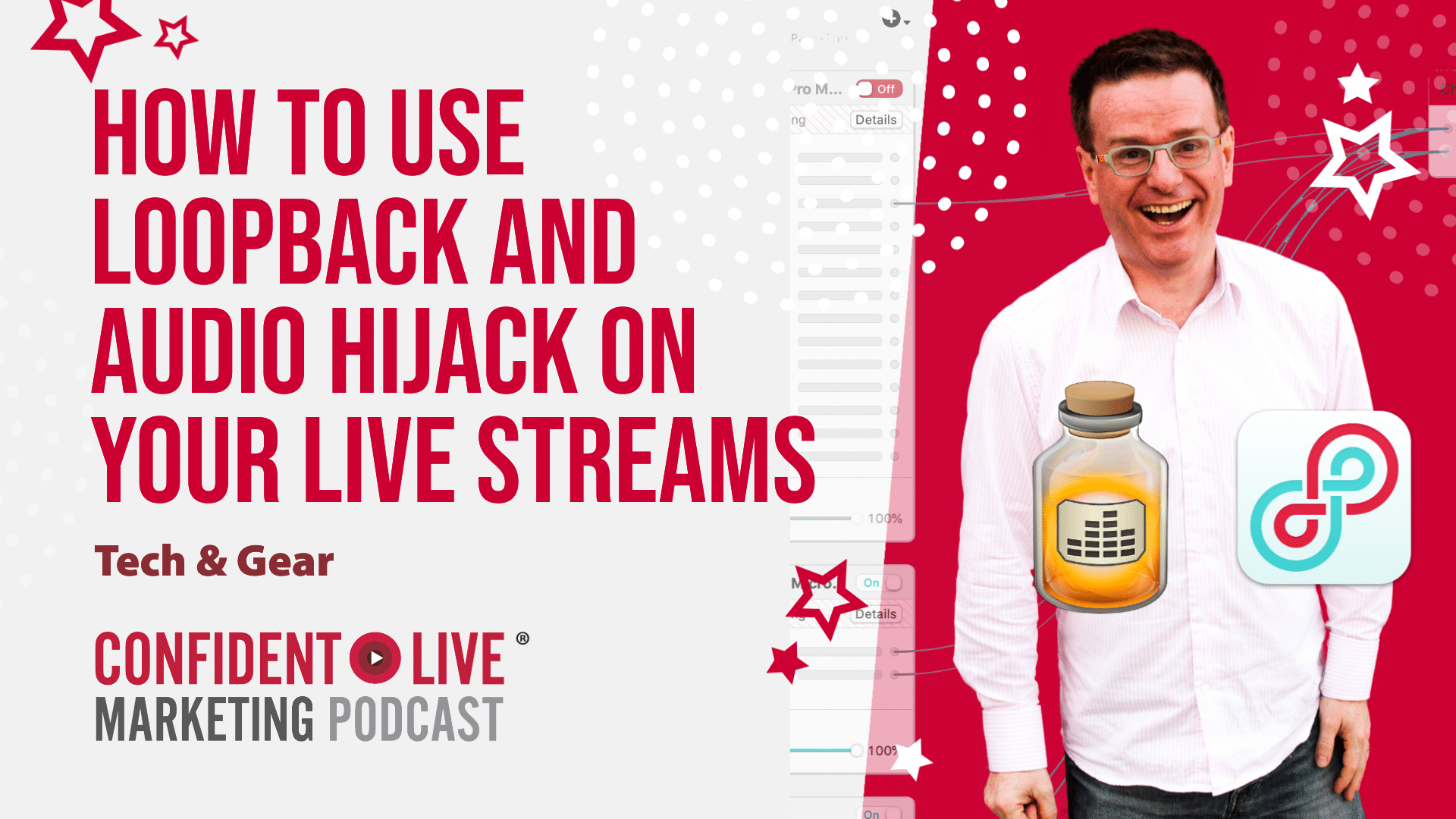How to use Loopback and Audio Hijack on Your Live Streams
Confident Live Marketing Podcast
Episode 105
Episode Theme: Tech & Gear
April 23, 2021

Are you a MAC user? Are you interested in leveling up your audio?
In this article I am discussing two really cool tools, Loopback and Audio Hijack, both from a software company called Rogue Amoeba.
Whether you use OBS Studio, Ecamm Live, Restream Studio or another tool, Loopback and Audio Hijack both allow you to do some really cool things. For example, you can route audio from another app, play sound effects on your live streams, add reverb and audio effects and so much more.
Read on, as I’ll be sharing how you can use these tools on your live streams!
This episode is sponsored by Restream and Launch Your Live
What Tools Do I Use To Improve My Audio Quality On Live Streams?
Listen at [01:48]
If you are a Mac user, there are a couple of really cool tools out there to help you level up your audio or solve some audio problems that you may be having.
The two tools that I'm going to be talking about today are from a software company called Rogue Amoeba (what a cool name). And the two tools are:
- Loopback
- Audio Hijack
Whether you're using OBS studio, Ecamm Live, Restream Studio or any other tool, Loopback and Audio Hijack allow you to do some really cool things.
For example, you can route audio from one app to another or add sound effects like reverb to your live show.
There are also lots of other things that I’m going to be showing you in this article!
What Can You Do With Loopback and Audio Hijack?
Listen at [05:50]
Back in early 2015 and 2016, I came across an issue that many Mac users face when recording live shows. Macs are great for creative types, however, they don’t natively capture audio from the desktop and other apps.
So, for example, if you are using something like OBS studio and you want to capture the audio from another app, then it’s either impossible, or you have to ensure you check the box that says ‘capture desktop audio’ via the tool it’s built into (ie. Zoom).
So, if someone wanted to bring a guest onto a live show and they were using a Mac, it wouldn’t automatically capture the audio.
Which was a problem...
After some research I found this tool called LoopBack. It’s not free, but in my opinion, it is the best software out there for this problem as it will allow you to route audio from OBS, Ecamm Live, or whatever tool you are using.
After some research I found this tool called LoopBack. It’s not free, but in my opinion, it is the best software out there for this problem as it will allow you to route audio from OBS, Ecamm Live, or whatever tool you are using.Click To TweetThe other tool is Audio Hijack. This is more of an assistant tool for your live show that allows you to do some pretty cool things like boosting audio, adding reverb, reducing noise, EQ tweaking, pitch changing, audio ducking and all that kind of cool stuff.
What Exactly is Loopback?
Listen at [11:11]
In essence, Loopback is a very simple tool that allows you to route audio from one tool to another. It also allows you to combine different audio devices at the same time.
In essence, Loopback is a very simple tool that allows you to route audio from one tool to another. It also allows you to combine different audio devices at the same time.Click To TweetWhen you are recording your live show you will have physical audio devices such as an external microphone or a built-in computer microphone. However, on Loopback, you can also create virtual audio devices.
This allows you to combine lots of different physical audio devices, such as multiple microphones. You can also route in the audio from another source, such as a video on Google Chrome, or Zoom or OBS studio.
"I created a virtual audio device in Loopback called ‘Chrome’ and what this does is take the audio from Google Chrome and then outputs that to the Chrome audio device"
Basically, what this allows you to do is capture audio from multiple inputs and devices at the same time.
What I usually do is use Loopback to capture audio and route it through Ecamm Live. This way you can bring in guests via Skype or Zoom as a virtual audio device and easily accommodate for multiple audio sources on your live show.
You can get a little advanced with this and record yourself and guests, as well as different types of audio on different tracks and files.
Loopback allows you to do lots of different things with your audio on a Mac.
What Exactly is Audio Hijack...
Listen at [27:12]
Audio Hijack looks similar to Loopback, and in many ways it is. For example, it allows you to record audio from any source in much the same way.
Their tagline is: "If you can hear it, you can record it".
But I believe that Audio Hijack offers so much more than that.
For me it really excels for live streamers in the effects department. You can add reverb, you can clean up the audio on the fly, and then with the power of Loopback you can route the audio somewhere else.
Alongside Loopback it can create some really cool sound effects, ensure that one sound is reduced when another audio source kicks in (ie. streamdeck sound reduces when I speak), can change the pitch or alter the sound in case your music or a guest just isn’t loud enough.
Can You Use A Rodecaster Instead of Loopback?
Listen at [35:09]
A couple of weeks ago I talked about using the Rodecaster Pro for live streams, which is great as you can use up to four microphones at the same time. You can use these alongside your computer audio, and add sound effects as well.
However, the Rodecaster doesn’t really help if you have a guest on or if you are using OBS Studio with Skype and want to route the audio from that into OBS.
The Rodecaster won’t help with this, it can do some cool things, however you will still need Loopback to route the audio from one app to another within your Mac.
So, you don’t need a Rodecaster if you want to use Loopback. And you don’t need to use Loopback if you have a Rodecaster.
But also remember, to get started with live video you don’t need any of this. You can keep it super simple with something like Restream, which I use regularly.
I use Ecamm Live with Restream, and then I use Loopback for lots of cooler things, and then Audio Hijack for all my Zoom meetings.
Resources
Watch Episode 105
Brought to you by Restream & Launch Your Live
Restream
Restream is the complete multi-streaming suite for entrepreneurs.
With Restream you can stream to multiple platforms all at the same time. They have a plethora of destinations including:
- LinkedIn Live
- Facebook Live
- YouTube Live
- Twitch
- Periscope and so much more
You can stream from another tool to Restream and Restream will take care of the multi-streaming for you really easily. Or you can broadcast directly from Restream to your platform of choice.
Restream also has chat, analytics and a scheduler. With the chat service you can view and engage with your audience from all the destinations you stream to.
I've been really blown away by the Analytics section - this shows your stream metrics - now many viewers, watched minutes, new followers and more.
And finally, the scheduler allows you to broadcast pre-recorded video live.
To sign up and have a play, visit iag.me/restream
Please Subscribe!
Don’t miss an episode! You can subscribe on Apple podcasts here - or on other podcast players.
The Confident Live Marketing Show
The Confident Live Marketing Show is a weekly live video show and podcast. It’s aimed at established entrepreneurs who want to level up their impact, authority and profits through the power of live video, webinars and podcasts. We’ll focus on knocking down the 3 main barriers these entrepreneurs face when creating live content - camera confidence/mindset, tech/gear and content marketing.
It’s hosted by Ian Anderson Gray. He is the founder of the Confident Live Marketing Academy and is the host of the Confident Live Marketing Podcast. He helps entrepreneurs to level up their impact, authority and profits by using live video confidently. He’s founder of Seriously Social - a blog focused on live video and social media tools. He’s an international speaker, trainer, teacher and consultant. He has a passion for making the techno-babble of live video and social media marketing easy to understand. As well as being a geek, husband, and dad to two kids, Ian is also a professional singer and lives near Manchester in the UK.




Comments